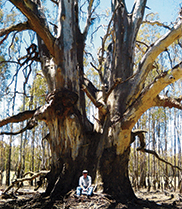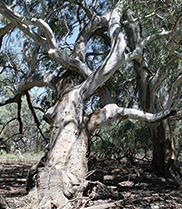River red gum – more than just a tree
Flooded Forest and Desert Creek: Ecology and History of the River Red Gum, a new CSIRO book, examines not only the ecology of one of the most iconic Australian trees, but how changes in attitudes towards it have reflected broader shifts in values of Australian society.
Author, CSIRO’s Dr Matthew Colloff, said that given the prominence of the river red gum in Australian culture, we know surprisingly little about the ecology and life history of it.
“This provides us with a greater understanding of the value of this tree as part of our common heritage and how we can manage river red gum forests under a drier future climate with reduced water availability”
Dr Matt Colloff, Land and Water
“The river red gum has been the subject of repeated government inquiries over its conservation, use and management. Despite this we know remarkably little about the basics of this species: its longevity; how deep its roots go; what proportion of its seedlings survive to adulthood; the diversity of organisms associated with it, and the nature of those associations,” Dr Colloff said.
Flooded Forest and Desert Creek describes what we do know about the biology and ecology of the river red gum, the changing landscape in which it lives and the shifting cultural context that has been shaped by our unfolding interactions with it. The author describes the factors that have driven change in river red gum forests – fire, grazing, timber harvesting, river regulation and diversions of water for irrigation – and examines how we have begun to move from a culture of exploitation to one of conservation, sustainable use and multiple values.
This shift in consciousness has been articulated in part through the depiction of river red gums and inland floodplains in art, literature and the media. Images of the tree by Hans Heysen, Henry Johnstone, Harold Cazneaux and Lin Onus are among the best-known and most-loved works of art in our public galleries.
The river red gum has the most widespread natural distribution of any eucalypt species in Australia, forming extensive forests and woodlands in the south-east and providing the structural and functional elements of important floodplain and wetland ecosystems. Along ephemeral creeks in arid central Australia it forms narrow corridors, providing vital refuge in the form of habitat and food resources for a whole host of animals in an otherwise hostile, arid environment.
Flooded Forest and Desert Creek also contrasts the interactions between people and the trees in arid central Australia, where the tree is sacred – standing for water, life and hope – with those further east in the Murray-Darling Basin, where conflicts between the allocation of water for irrigated agricultural production and for the environment are still being played out.
“This provides us with a greater understanding of the value of this tree as part of our common heritage and how we can manage river red gum forests under a drier future climate with reduced water availability” Dr Colloff said.
Media resources
Click image for high resolution version


